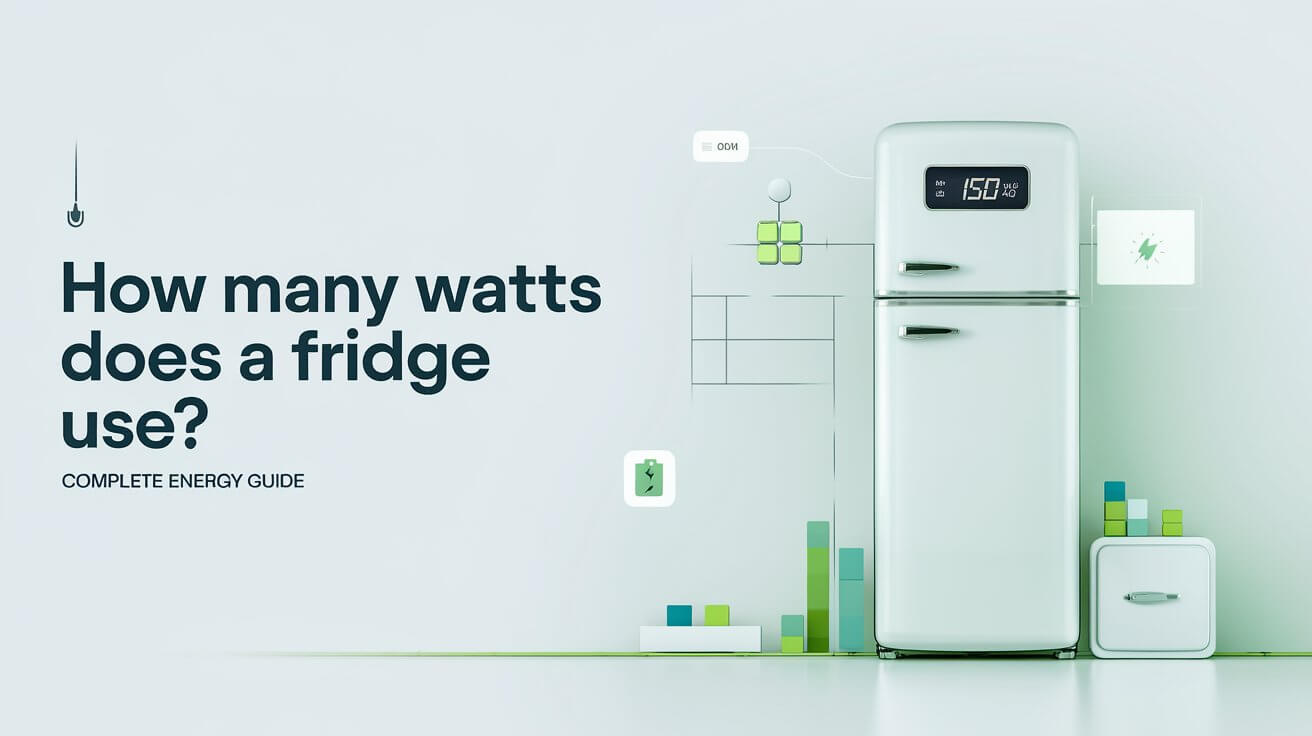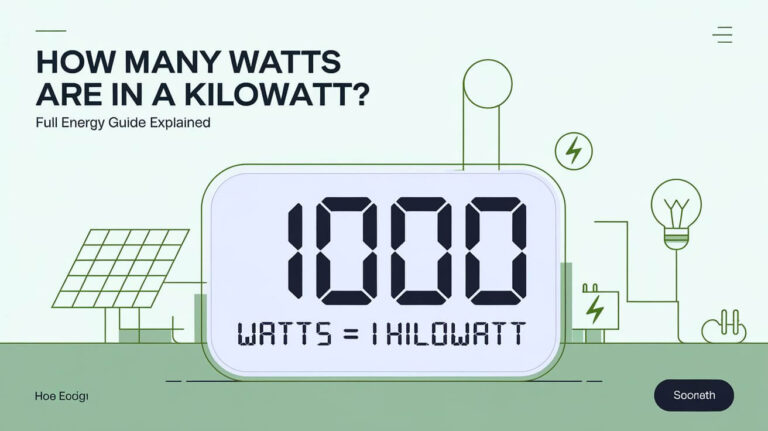How Many Watts Does a Fridge Use? Complete Energy Guide

Knowing how many watts your refrigerator uses is important for managing electricity costs, planning backup power solutions, and understanding overall household energy consumption. On average, refrigerators use between 100 and 800 watts depending on the model, size, and type. In this post, we’ll break down everything you need to know about fridge wattage and energy consumption, helping you optimize your refrigerator’s energy usage.
What Is the Average Wattage of a Refrigerator?
The wattage of a refrigerator typically falls between 100 and 400 watts for standard home fridges. Larger models, especially those with freezers or extra features like ice dispensers, can use up to 800 watts. The wattage range can vary greatly depending on:
- The size of the refrigerator
- Its age and energy efficiency rating
- The features it has (such as ice makers or water dispensers)
- Whether it’s a mini-fridge, standard fridge, or commercial unit
For example, a standard home refrigerator might use 150-300 watts on average during normal operation, while a larger side-by-side model could consume as much as 800 watts when fully powered.
Factors Affecting a Refrigerator’s Wattage
Size of the Fridge
One of the biggest factors influencing wattage is the size of the refrigerator. Here’s how different fridge sizes compare:
- Mini-Fridges: These compact units use between 85-100 watts. They’re more energy-efficient because of their smaller internal volume, but they don’t offer as much storage.
- Standard Refrigerators: Full-sized fridges, typically found in most homes, use around 150-400 watts. The larger the fridge, the more energy it needs to maintain the internal temperature.
- Commercial Refrigerators: Commercial or industrial refrigerators, often used in restaurants or large kitchens, can consume 800-1500 watts or more due to their larger size and increased cooling demands.
Type of Refrigerator
Different types of refrigerators also vary in their energy consumption:
- Top-Freezer Refrigerators: These tend to use less energy, averaging around 150-300 watts, because they maintain more consistent cooling between compartments.
- Bottom-Freezer Refrigerators: Bottom-freezers use slightly more power, ranging from 200-400 watts, as it takes more energy to keep the freezer section cooler.
- Side-by-Side Refrigerators: These models often consume the most energy, typically 350-800 watts, due to their larger freezer sections and additional features like ice makers.
Energy Efficiency Rating
The age and efficiency of a refrigerator play a critical role in energy consumption. Older refrigerators, especially those made before 2001, can consume up to 1,000 watts, while newer ENERGY STAR models are designed to be more efficient and use significantly less power, often between 100-400 watts.
Opting for an energy-efficient model can save money on your energy bills. For instance, an energy-efficient refrigerator could reduce energy consumption by up to 20% compared to older models.
Calculating Fridge Wattage
Using the Fridge Label
One easy way to determine how many watts your refrigerator uses is by checking the EnergyGuide label on the unit. This label often provides the fridge’s power consumption in kilowatt-hours (kWh). To calculate wattage, multiply the voltage by the amperage:
Watts = Volts x Amps
For example, if your refrigerator operates at 120 volts and draws 5 amps, the wattage is:
Watts = 120V x 5A = 600W
This method provides an accurate measurement based on your specific appliance’s power draw.
Calculating Usage Over Time
To calculate your fridge’s energy consumption over time, you need to estimate the total hours the fridge is running. Most fridges do not run continuously; they cycle on and off as needed to maintain the internal temperature. A common method to estimate running time is to assume the refrigerator runs for about 8 hours a day.
For example, if a 500-watt fridge runs for 8 hours a day, the energy consumption would be:
500 watts x 8 hours = 4000 watt-hours or 4 kWh per day.
At an average electricity rate of $0.12 per kWh, the daily cost to run this fridge would be:
4 kWh x $0.12/kWh = $0.48 per day.
Running Watts vs. Starting Watts
What Are Running Watts?
Running watts refer to the electricity a refrigerator uses while maintaining its internal temperature. This is typically lower than the maximum wattage and ranges from 100-400 watts for most standard refrigerators. Running watts reflect the fridge’s steady-state power draw once the compressor has kicked in.
What Are Starting Watts?
Starting watts, also known as surge watts, are higher because refrigerators need more power when the compressor first turns on. Starting wattage can range between 600-1200 watts, depending on the size and type of the refrigerator. However, this high wattage only lasts for a few seconds before dropping to the running wattage.
It’s important to know both the starting and running watts if you plan to run your refrigerator on a generator or solar system.
How to Reduce a Fridge’s Energy Consumption
Opt for Energy-Efficient Models
Upgrading to an ENERGY STAR-rated refrigerator can significantly reduce electricity usage. These models are designed to use at least 15-20% less energy than standard models without compromising performance. Over time, the savings on energy bills can make up for the higher upfront cost of an energy-efficient appliance.
Regular Maintenance Tips
Routine maintenance can help your refrigerator run more efficiently, reducing its power consumption:
- Clean the coils: Dust and dirt can accumulate on the fridge’s condenser coils, making it harder for the appliance to cool. Clean the coils regularly to improve energy efficiency.
- Check door seals: Ensure the refrigerator door seals tightly. A faulty door seal allows cold air to escape, causing the fridge to work harder and use more power.
- Defrost regularly: If your fridge has a manual defrost option, make sure to defrost it regularly. Ice buildup can reduce efficiency.
Proper Placement
Where you place your refrigerator also impacts energy consumption. Avoid placing it next to heat sources like ovens or in direct sunlight, as the added heat forces the fridge to work harder. Ensure there’s enough ventilation space around the unit so that heat can dissipate effectively.
How Many Watts Does a Mini Fridge Use?
Mini fridges are more energy-efficient than full-sized refrigerators due to their smaller size. A typical mini fridge consumes between 50 and 100 watts, though it can increase based on its size, age, and features. Mini fridges with built-in freezers use more power than those designed solely for refrigeration.
For college dorms or small apartments, mini fridges are a popular option because they consume less energy. However, they may not be as energy-efficient per cubic foot of storage compared to larger, energy-efficient models.
How Many Watts Does a Commercial Refrigerator Use?
Commercial refrigerators, such as those found in grocery stores, restaurants, and catering businesses, are much larger than standard home fridges. As a result, they require significantly more power, often ranging between 800 and 1500 watts or more, depending on the size and the specific use case.
In addition to the standard commercial units, walk-in refrigerators can use thousands of watts to maintain large volumes of food at safe temperatures. The energy costs for these refrigerators can be substantial, which is why commercial businesses often invest in energy-efficient models.
What Is the Cost of Running a Fridge?
Estimating Electricity Costs
The cost to run a refrigerator depends on how many watts it uses, how long it runs each day, and the cost of electricity in your area. Use this formula to estimate your fridge’s daily and monthly costs:
Wattage x Hours per Day / 1,000 = Daily kWh
Daily kWh x Electricity Cost per kWh = Daily Cost
For instance, a 500-watt refrigerator running for 8 hours a day would consume 4 kWh per day. At $0.12 per kWh, the cost would be:
4 kWh x $0.12/kWh = $0.48 per day.
Over a month, this would amount to $14.40, and over a year, the cost would be approximately $175.
Comparison of Old vs. New Models
Older refrigerators tend to use more power than newer, energy-efficient models. While an older fridge might cost $20 or more per month to run, an efficient new model could lower that cost to $10-$15 per month, depending on local electricity rates and usage patterns.
Off-Grid and Backup Power for Refrigerators
Running a Fridge on a Generator
If you live in an area prone to power outages or are planning an off-grid lifestyle, it’s important to understand how to power a refrigerator using a generator. Since refrigerators require higher starting watts, ensure that the generator can handle at least 1,200 surge watts for a standard fridge.
For continuous operation, a generator that provides 500-800 running watts should suffice for most home refrigerators. However, make sure to calculate the total power needs if you’re running multiple appliances at once.
Solar Power for Refrigerators
Using solar power to run a fridge is a great way to reduce energy costs, especially in areas with abundant sunlight. To determine how many solar panels you need, calculate your fridge’s daily energy consumption (in kWh) and compare it to the output of your solar panel system.
For example, if your fridge consumes 4 kWh per day, you’ll need enough solar panels to generate at least 4 kWh daily, and you may need battery storage to power the fridge duringbattery charging times. Depending on the solar panel system’s efficiency and sunlight availability, you may need a backup power source, like a generator or a battery bank, to ensure continuous operation during cloudy days or nighttime.
FAQs on Fridge Power Usage
Does a Fridge Use a Lot of Electricity?
While refrigerators run continuously, they aren’t necessarily the largest consumers of electricity in the home. However, because they operate 24/7, they can contribute significantly to your monthly energy bill. Depending on the model and usage, a standard fridge can account for about 10-15% of household energy consumption.
How Can I Tell How Much Power My Fridge Uses?
The most accurate way to determine your refrigerator’s power usage is by checking the EnergyGuide label or using a power meter. These devices can give real-time data on how many watts your fridge is using during different parts of its cooling cycle.
Can I Run a Refrigerator on Battery Power?
Yes, it’s possible to run a refrigerator on battery power, but it requires careful planning. You will need a battery with enough capacity to support the fridge’s power demands for the desired duration. For example, a 500-watt fridge running for 10 hours would require a 5,000 Wh battery. Additionally, you would need an inverter to convert the battery’s DC power to AC, which most refrigerators use.
Conclusion
Understanding how many watts a fridge uses can help you manage energy costs, make informed decisions when purchasing a new model, and prepare for power outages or off-grid living. On average, most refrigerators consume between 100-800 watts, with larger and more feature-rich models consuming more power. By choosing an energy-efficient fridge and following proper maintenance, you can significantly reduce your electricity bill while ensuring your appliance runs optimally.
If you’re concerned about the energy consumption of your refrigerator, consider upgrading to an ENERGY STAR-rated model, keeping it well-maintained, and placing it in a well-ventilated, cool space. With careful planning, you can maximize your fridge’s efficiency and minimize its impact on your energy costs.




